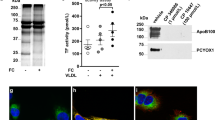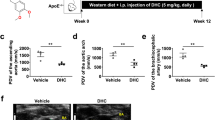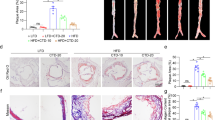Abstract
Paraoxonase (PON) possesses antiatherogenic potentials, but the distinct functions of PON members in alleviating atherosclerosis are not yet clear. This study aimed to evaluate the protective effects of hPON1 and hPON3 against atherosclerosis, and thereby exploring their synergistic mechanism in atherosclerosis development. We generated the recombinant adenovirus AdPON1 and AdPON3, which were capable of expressing hPON1 and hPON3. After AdPON1 and AdPON3 were injected intravenously into 5-week-old apolipoprotein E knockout mice, abundant hPON1 and hPON3 mRNA expression levels were detected. However, increase in serum lactonase activity was detected only in AdPON1-treated mice. Serum antioxidation and anti-inflammation capabilities in AdPON1-treated mice, reflected by malondialdehyde, total antioxidant capability and tumor necrosis factor-α levels, were greatly enhanced, whereas those in AdPON3-treated mice were not significantly affected. Nevertheless, histological analysis revealed that adenovirus-mediated expression of hPON1, hPON3 or both of them reduced atherosclerotic plaque area to a similar extent. Although no synergistic mechanism was detected in reducing arterial lesion size, hPON1 and hPON3 showed synergistic effects on promoting macrophage cholesterol efflux. In conclusion, hPON1 and hPON3 exhibited similar potentials in reducing arterial lesion size, but they exerted antiatherogenic effects in distinct ways.
This is a preview of subscription content, access via your institution
Access options
Subscribe to this journal
Receive 12 print issues and online access
$259.00 per year
only $21.58 per issue
Buy this article
- Purchase on Springer Link
- Instant access to full article PDF
Prices may be subject to local taxes which are calculated during checkout






Similar content being viewed by others
References
Kleemann R, Zadelaar S, Kooistra T . Cytokines and atherosclerosis: a comprehensive review of studies in mice. Cardiovasc Res 2008; 79: 360–376.
Lusis AJ . Atherosclerosis. Nature 2000; 407: 233–241.
Aviram M, Rosenblat M . Paraoxonases 1, 2, and 3, oxidative stress, and macrophage foam cell formation during atherosclerosis development. Free Radic Biol Med 2004; 37: 1304–1316.
Shih DM, Xia YR, Wang XP, Miller E, Castellani LW, Subbanagounder G et al. Combined serum paraoxonase knockout/apolipoprotein E knockout mice exhibit increased lipoprotein oxidation and atherosclerosis. J Biol Chem 2000; 276: 17527–17535.
Harel M, Aharoni A, Gaidukov L, Brumshtein B, Khersonsky O, Meged R et al. Structure and evolution of the serum paraoxonase family of detoxifying and anti-atherosclerotic enzymes. Nat Struct Mol Biol 2004; 11: 412–419.
Draganov DI, Stetson PL, Watson CE, Billecke SS, La Du BN . Rabbit serum paraoxonase 3(PON3) is a high density lipoprotein-associated lactonase and protects low density lipoprotein against oxidation. J Biol Chem 2000; 275: 33435–33442.
Mackness B, Durrington PN, McElduff P, Yarnell J, Azam N, Watt M et al. Low paraoxonase activity predicts coronary events in the Caerphilly Prospective Study. Circulation 2003; 107: 2775–2779.
Shih DM, Gu L, Xia YR, Navab M, Li WF, Hama S et al. Mice lacking serum paraoxonase are susceptible to organophosphate toxicity and atherosclerosis. Nature 1998; 394: 284–287.
Tward A, Xia YR, Wang XP, Shi YS, Park C, Castellani LW et al. Decreased atherosclerotic lesion formation in human serum paraoxonase transgenic mice. Circulation 2002; 106: 484–490.
Aviram M, Rosenblat M . Paraoxonases and cardiovascular diseases: pharmacological and nutritional influences. Curr Opin Lipidol 2005; 16: 393–399.
Aviram M, Rosenblat M, Bisgaier CL, Newton RS, Primo-Parmo SL, La Du BN . Paraoxonase inhibits high density lipoprotein (HDL) oxidation and preserves its functions: a possible peroxidative role for paraoxonase. J Clin Invest 1998; 101: 1581–1590.
Rozenberg O, Shih DM, Aviram M . Human serum paraoxonase (PON1) decreases macrophage cholesterol biosynthesis: a possible role for its phospholipase-A2 activity and lysophosphatidylcholine formation. Arterioscler Thromb Vasc Biol 2003; 23: 461–467.
Ng CJ, Bourquard N, Hama SY, Shih D, Grijalva VR, Navab M et al. Adenovirus-mediated expression of human paraoxonase 3 protects against the progression of atherosclerosis in apolipoprotein E-deficient mice. Arterioscler Thromb Vasc Biol 2007; 27: 1368–1374.
Shih DM, Xia YR, Wang XP, Wang SS, Bourquard N, Fogelman AM et al. Decreased obesity and atherosclerosis in human paraoxonase 3 transgenic mice. Circ Res 2007; 100: 1200–1207.
Ng CJ, Shih DM, Hama SY, Villa N, Navab M, Reddy ST . The paraoxonase gene family and atherosclerosis. Free Radic Biol Med 2005; 38: 153–163.
Draganov DI, Teiber JF, Speelman A, Osawa Y, Sunahara R, La Du BN . Human paraoxonases (PON1, PON2, and PON3) are lactonases with overlapping and distinct substrate specificities. J Lipid Res 2005; 46: 1239–1247.
Gaidukov L, Tawfik DS . High affinity, stability, and lactonase activity of serum paraoxonase PON1 anchored on HDL with ApoA-I. Biochemistry 2005; 44: 11843–11854.
Berliner JA, Watson AD . A role for oxidized phospholipids in atherosclerosis. N Engl J Med 2005; 353: 9–11.
Kirii H, Niwa T, Yamada Y, Wada H, Saito K, Iwakura Y et al. Lack of interleukin-1beta decreases the severity of atherosclerosis in ApoE-deficient mice. Arterioscler Thromb Vasc Biol 2003; 23: 656–660.
Fazio S, Babaev VR, Murray AB, Hasty AH, Carter KJ, Gleaves LA et al. Increased atherogenesis in mice reconstituted with apolipoprotein E null macrophages. Proc Natl Acad Sci USA 1997; 94: 4647–4652.
Wang N, Silver DL, Costet P, Tall AR . Specific binding of ApoA1, enhanced cholesterol efflux and altered plasma membrane morphology in cells expressing ABCA1. J Biol Chem 2000; 275: 33053–33058.
Kennedy MA, Barrera GC, Nakamura K, Baldán A, Tarr P, Fishbein MC et al. ABCG1 has a critical role in mediating cholesterol efflux to HDL and preventing cellular lipid accumulation. Cell Metab 2005; 1: 121–131.
Draganov DI . Human PON3, effects beyond the HDL. Circ Res 2007; 100: 1104–1105.
Liu Y, Mackness B, Mackness M . Comparison of the ability of paraoxonases 1 and 3 to attenuate the in vitro oxidation of low-density lipoprotein and reduce macrophage oxidative stress. Free Radic Biol Med 2008; 45: 743–748.
Mackness B, Quarck R, Verreth W, Mackness M, Holvoet P . Human paraoxonase-1 overexpression inhibits atherosclerosis in a mouse model of metabolic syndrome. Arterioscler Thromb Vasc Biol 2006; 26: 1545–1550.
Khersonsky O, Tawfik DS . Structure-reactivity studies of serum paraoxonase PON1 suggest that its native activity is lactonase. Biochemistry 2005; 44: 6371–6382.
Rosenblat M, Oren R, Aviram M . Lysophosphatidylcholine (LPC) attenuates macrophage mediated oxidation of LDL. Biochem Biophys Res Comm 2006; 344: 1271–1277.
Canault M, Peiretti F, Mueller C, Kopp F, Morange P, Rihs S et al. Exclusive expression of transmembrane TNF-alpha in mice reduces the inflammatory response in early lipid lesions of aortic sinus. Atherosclerosis 2004; 172: 211–218.
Ohta H, Wada H, Niwa T, Kirii H, Iwamoto N, Fujii H et al. Disruption of tumor. necrosis factor-alpha gene diminishes the development of atherosclerosis in ApoE-deficient mice. Atherosclerosis 2005; 180: 11–17.
Lind L . Circulating markers of inflammation and atherosclerosis. Atherosclerosis 2003; 169: 203–214.
Devlin CM, Kuriakose G, Hirsch E, Tabas I . Genetic alterations of IL-1 receptor antagonist in mice affect plasma cholesterol level and foam cell lesion size. Proc Natl Acad Sci USA 2002; 99: 6280–6285.
Chi H, Messas E, Levine RA, Graves DT, Amar S . Interleukin-1 receptor signaling mediates atherosclerosis associated with bacterial exposure and/or a high-fat diet in a murine apolipoprotein E heterozygote model: pharmacotherapeutic implications. Circulation 2004; 110: 1678–1685.
Rader DJ . Molecular regulation of HDL metabolism and function: implications for novel therapies. J Clin Invest 2006; 116: 90–100.
Joy T, Hegele RA . Is raising HDL a futile strategy for atheroprotection? Nat Rev Drug Discov 2008; 7: 143–155.
Guns PJ, Assche TV, Verreth W, Fransen P, Mackness B, Mackness M et al. Paraoxonase 1 gene transfer lowers vascular oxidative stress and improves vasomotor function in apolipoprotein E-deficient mice with pre-existing atherosclerosis. Brit J Pharmacol 2008; 153: 508–516.
Lv HQ, Zhu J, Zang YH, Ze YG, Qin JC . Cloning, high level expression of human paraoxonase-3 in Sf9 cells and pharmacological characterization of its product. Biochem Pharmacol 2005; 70: 1019–1025.
Van Eck M, Herijgers N, Van Dijk KW, Havekes LM, Hofker MH, Groot P et al. Effect of macrophage-derived mouse ApoE, human ApoE3-Leiden, and human ApoE2 (Arg1583Cys) on cholesterol levels and atherosclerosis in ApoE-deficient mice. Arterioscler Thromb Vasc Biol 2000; 20: 119–127.
Acknowledgements
The study was supported by the National Natural Science foundation of China (Grant no. 30670858) to Junchuan Qin and Key Project of National Natural Science foundation of China (Grant no. 90713015) to Ju Huangxian.
Author information
Authors and Affiliations
Corresponding authors
Ethics declarations
Competing interests
The authors declare no conflict of interest.
Rights and permissions
About this article
Cite this article
Zhang, C., Peng, W., Wang, M. et al. Studies on protective effects of human paraoxonases 1 and 3 on atherosclerosis in apolipoprotein E knockout mice. Gene Ther 17, 626–633 (2010). https://doi.org/10.1038/gt.2010.11
Received:
Revised:
Accepted:
Published:
Issue Date:
DOI: https://doi.org/10.1038/gt.2010.11
Keywords
This article is cited by
-
Individual variations in cardiovascular-disease-related protein levels are driven by genetics and gut microbiome
Nature Genetics (2018)
-
Dysfunctional HDL and atherosclerotic cardiovascular disease
Nature Reviews Cardiology (2016)
-
Paraoxonase 1 polymorphism Q192R affects the pro-inflammatory cytokine TNF-alpha in healthy males
BMC Research Notes (2011)



